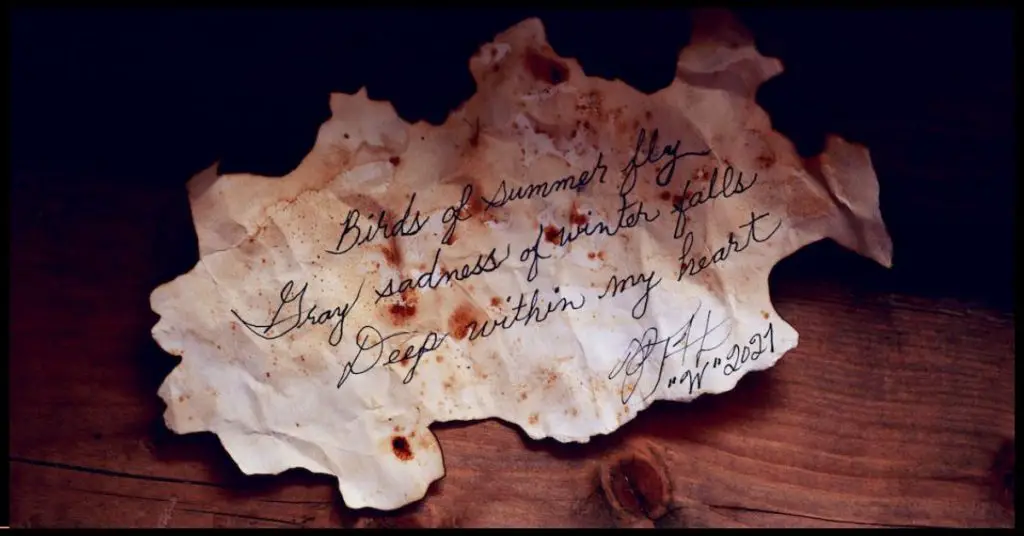haiku poems

Welcome to our blog post on haiku poetry, the minimalist masterpiece that says so much with so little.
Haiku is a form of Japanese poetry that has been enjoyed for centuries for its beauty and simplicity.
With just three lines and a strict syllable count of 5-7-5, haiku manages to pack a lot of meaning and emotion into a small space. In this blog post, we’ll be exploring 13 haiku poems that showcase the power of this ancient art form.
We’ll look at the structure and themes of haiku, as well as some tips for writing your own haiku. So without further ado, let’s dive into the world of haiku poetry!
Table of Contents
Affiliate Disclaimer: This content contains affiliate links. When you buy through these links, I may earn an affiliate commission.
The Structure of Haiku
The structure of a Haiku allows for concise expression and can be used to convey strong emotion without using too many words or being overly descriptive.
Moreover, each poem must include two images that capture an idea or moment in time; these images should be related to one another but remain separate as well.
Typically these images will involve something from nature since this theme is so common in Haikus.
The Themes of Haiku
The most common themes found in haiku are those pertaining to nature and the changing seasons.
This is because these poems were originally written by Japanese farmers who wanted to capture the beauty of their surroundings in their verses.
Additionally, many other topics such as love, life, death, and mortality are also featured prominently in these works of art.
Haikus can even be used to convey feelings such as nostalgia or joy without ever mentioning specific objects or events.
Writing Haiku
The beauty of haiku is that they rely heavily on imagery to evoke emotion in the reader, which allows the writer to be creative while still following a set structure.
By simply observing nature or everyday life, writers can create thought-provoking haikus that leave readers with an engaging experience.
Although it may take some time to become comfortable with the structure and conventions associated with haiku, it’s well worth it when you see how these poetic works can capture your imagination.
Tips for Getting Started
Here are a few tips to help you get started writing haiku:
- Familiarize yourself with the structure and syllable count of haiku. Haiku consists of three lines, with a syllable count of 5-7-5. This structure is an important part of the form and helps to create a sense of balance and rhythm.
- Look for inspiration in the natural world. Haiku is often centered around themes of nature and the seasons, so consider going for a walk or spending time in nature to find inspiration for your haiku.
- Pay attention to the changing seasons. Haiku often incorporates imagery related to the seasons, so consider the time of year when you’re writing your haiku.
- Experiment with different structures and themes. While traditional haiku often follows the 5-7-5 syllable count and nature-based themes, there are no hard and fast rules when it comes to writing haiku. Feel free to play around with different structures and themes to find what works best for you.
- Edit and revise your haiku. Don’t be afraid to experiment with different word choices and phrasing as you revise your haiku. A good haiku often goes through many drafts before it’s finalized.
Ideas for Finding Inspiration
Here are a few ideas for finding inspiration to write haiku:
Observe the natural world around you. Haiku is often inspired by the beauty of nature, so consider spending time in outdoors and paying attention to your surroundings.
Keep a notebook with you. Jot down any ideas, phrases, or images that catch your attention as you go about your day. These notes can be a great source of inspiration when you sit down to write your haiku.
Consider the changing seasons. Each season has its own unique characteristics and beauty, so consider writing haiku that reflect the season you’re in.
Take a walk and pay attention to your surroundings. Walking can help to clear your mind and allow you to focus on your surroundings. As you walk, pay attention to the sights, sounds, and smells around you.
Reflect on your own personal experiences. Haiku can also be inspired by personal emotions and experiences, so consider writing about something that has moved or affected you deeply.
How to Revise and Edit Haiku
Here are a few tips for revising and editing haiku:
- Check the syllable count. Make sure that each line of your haiku adheres to the traditional syllable count of 5-7-5.
- Focus on imagery and concision. Haiku relies on vivid imagery and a sense of economy with words. Consider whether each word in your haiku is necessary and adds to the overall impact of the poem.
- Experiment with different word choices. Try replacing certain words with synonyms or phrases to see if it improves the poem.
- Read your haiku out loud. Reading your haiku out loud can help you catch any awkward phrasing or unnecessary words.
- Seek feedback from others. Consider sharing your haiku with a writing group or trusted friends and family to get their perspectives on your poem.
Remember, revision is an important part of the writing process, and it’s okay to go through several drafts of your haiku before you feel satisfied with the final product.
Examples of Haiku
Haiku is a form of Japanese poetry that is characterized by its use of three lines and a strict syllable count of 5-7-5.
Themes of haiku often center around nature and the seasons, as well as moments of insight or enlightenment. Here are a few examples of haiku that showcase these themes:
Moonlight–
A worm digs silently
Into the chestnut.
In the cicada’s cry
No sign can foretell
How soon it must die.
A world of dew,
And within every dewdrop
A world of struggle.
In these examples, we can see how haiku poets use imagery and symbolism to convey a sense of the natural world and the passing of time.
Haiku often aims to capture a fleeting moment or emotion, making it a unique and evocative form of poetry.
A selection of classic haiku by poets such as Basho, Buson, and Issa
Haiku is an ancient form of Japanese poetry. These short, poetic verses, often composed of just three lines, have come to be a beloved form of expression throughout the world.
The most notable haiku poets are Basho, Buson, and Issa; they were members of the Edo period who each had their own distinct style.
Basho was known for his minimalist approach to writing haikus, often packing huge amounts of emotion into only a few words.
He wrote about inner feelings and spiritual observations in nature.
Buson had a unique eye for detail when it came to appreciating the beauty in nature; his imagery is unparalleled in its vividness.
Issa’s work was focused on depicting the sorrowful aspects of life with great sympathy and understanding.
Here are a few classic haiku by the poets’ Basho, Buson, and Issa:
Haiku Poems by Matsuo Basho:
The summer grasses.
All that remains
Of warriors’ dreams.
The early summer rain
Fall and fall yet
Leave untouched Hikari-do Hall.
Haiku Poems by Yosa Buson:
The fading of spring.
The feeling of holding
Of the biwa.
The canola flowers.
The moon in the east.
The sun in the west.
Haiku Poems by Kobayashi Issa:
All the time I pray to Buddha
I keep on
killing mosquitoes.
Even with insects—
some can sing,
some can’t.
Mosquito at my ear—
does he think
I’m deaf?
Modern Haiku by Contemporary Poets
Here are a few examples of modern haiku by contemporary poets:
Snowflakes whisper
secrets to the waiting earth–
winter solstice
In the stillness
of this summer night, fireflies
dance and shine
A lone leaf falls
to the ground, a reminder
of what was
These haiku showcase the timeless themes of nature and the passing of time, while also bringing in more modern elements and imagery.
Haiku poetry continues to thrive and evolve in the modern world, with poets around the globe finding inspiration in the natural world and their own personal experiences.
Final Thoughts on Haiku Poems
Finally, haiku poems are a distinct and evocative form that has withstood the test of time.
Haiku, with its tight word count and emphasis on nature and seasons, provides a unique viewpoint on the world around us. Haiku is a rewarding form to study whether you’re a seasoned poet or just starting out.
Its conciseness and concentration on imagery may both challenge and inspire authors of all skill levels. So why not try your hand at haiku? Who knows where it will lead you?




Leave a Reply